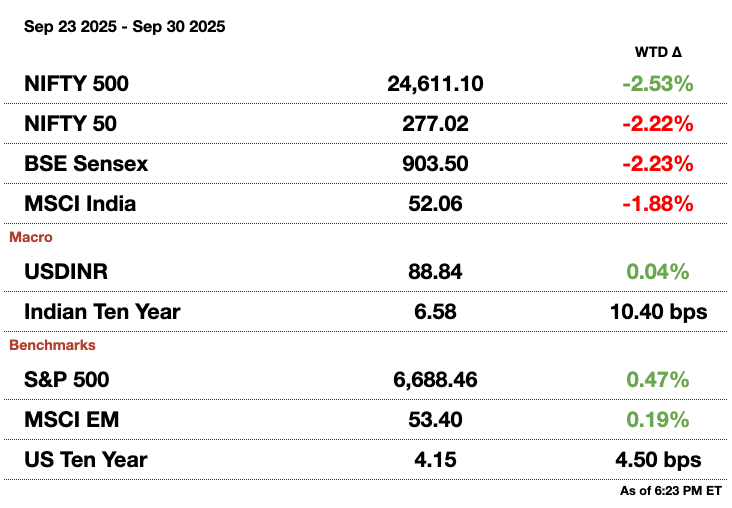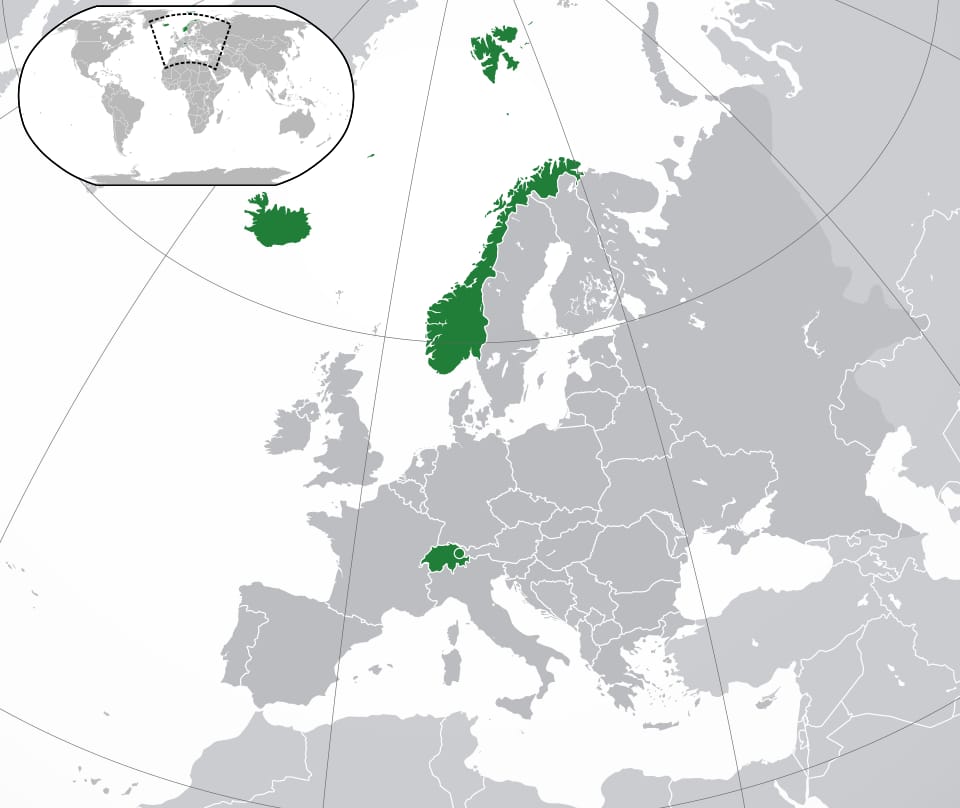- Samosa Capital
- Posts
- 📰RBI Rate Cut Back in Play | Daily India Briefing
📰RBI Rate Cut Back in Play | Daily India Briefing
Three stories on Indian markets that you can't miss.


Today’s deep dives: 40 percent of surveyed economists see a quarter-point rate cut. India extends timeline for retail algorithmic trading rollout. India’s trade pact with the European Free Trade Association starts tomorrow.
We want to talk to you! Just respond to this email and we’ll set up a time to learn more about how Samosa Capital can be more helpful in your work.
If you have any questions about India, fill out this form or reach out to Shreyas at [email protected]



Macro
U.S. visa restrictions under Trump are pushing companies to shift more high-value work to India. Global capability centers (GCCs) in India, already handling operations from finance to R&D, are now expected to take on more strategic and innovation-led functions due to rising H-1B visa costs. This trend is particularly strong in AI, cybersecurity, product development, and analytics, as U.S. firms seek to retain critical talent in-house.
Analysts say India’s central bank can still cut rates despite a weak rupee, as inflation remains low and foreign reserves are sufficient to manage currency volatility. While the rupee has hit record lows amid U.S. trade tensions, a rate cut is seen as a tool to support growth. Diverging from the consensus to hold rates, some analysts argue the monetary easing could offset negative trade impacts and stimulate domestic consumption.
Less than 10 percent of Indian households have invested in securities markets, according to a survey by SEBI and Kantar of nearly 92,000 households. Most households prioritize capital preservation over higher-return, riskier assets, though penetration is higher in urban areas and top metros. Barriers to investment include complexity, lack of information, and fear of losses, signaling room to expand India’s investor base.
Gold prices in India hit record highs, heading for their best month in 14 years amid fears of a U.S. government shutdown and soft U.S. jobs data boosting expectations of Federal Reserve rate cuts. Spot gold rose 0.3 percent to $3,843.43 per ounce, with an 11.5 percent gain so far in September, the largest since August 2011. Investors are flocking to the safe haven as market uncertainty grows, while silver and platinum also see significant monthly gains.
Equities
India’s stock benchmarks opened flat after a seven-session losing streak, with monthly gains led by state-owned banks and auto stocks following tax cuts. The Nifty 50 and BSE Sensex had shed about 3 percent over the past eight sessions but rose 0.8 percent and 0.6 percent in September, respectively. Broader advances were capped by U.S. tariffs and higher H-1B visa fees affecting IT firms.
India’s financial crime agency searched six Reliance Infrastructure premises over a 2010 toll road contract, not foreign exchange violations as initially reported. Reliance clarified it had no connection with the contractor and the toll road has been under the National Highways Authority of India for the past four years. The agency’s inquiry is linked solely to the historical Rajasthan project.
The finance chief of India’s Adani Total Gas Ltd has resigned. Parag Parikh stepped down, and the company is in the process of appointing a replacement, with an official announcement expected soon. The departure comes amid ongoing developments in India’s energy sector, though no specific reasons for his resignation were provided.
India is expected to face above-average rainfall in October, threatening summer-sown crops, with precipitation projected at more than 115 percent of the 50-year average. The heavy rain could damage rice, cotton, soybeans, corn, and pulses, particularly in central, eastern, and southern regions, delaying monsoon withdrawal and affecting harvests. Farmers urgently need dry weather to prevent losses, as nearly half of India’s farmland is rain-dependent and cannot rely on irrigation.
Alts
India’s Infra.Market has filed for an IPO under the confidential route, allowing it to keep details private until the launch. The construction materials supplier recently raised $82.4 million (₹7.32 billion) from Tiger Global and Accel, following a $121 million round in January at a $2.8 billion valuation. The firm supplies cement, tiles, and paints to large-scale infrastructure projects across India.
LG Electronics India is seeking a valuation of $8.7 billion in its IPO, planning to raise up to $1.32 billion (₹116 billion) by selling a 15 percent stake of its Indian unit. The three-day IPO runs from October 7-9, with a price band of $12.27–$12.95 (₹1,080–1,140) per share, amid a strong Indian IPO market this year. The appliance maker competes with Samsung and Whirlpool, selling refrigerators, washing machines, and TVs, with the domestic market expected to grow 12 percent annually until 2029.
Nine workers were killed in an accident at a thermal power plant under construction in Chennai, India. The incident occurred when a steel arch collapsed at the Ennore SEZ Supercritical Thermal Power Project, leaving one additional worker injured. Officials from Bharat Heavy Electricals Ltd., the contractor, responded to the site, while both the Tamil Nadu Chief Minister and Prime Minister Modi expressed their condolences.
Policy
New India Assurance has been ordered to pay $270.3 million (₹23.79 billion) by the tax authority over alleged past dues on co-insurance premiums and reinsurance commissions. The state-backed insurer plans to appeal, citing a 2024 central tax clarification classifying such transactions as non-taxable. Despite the order, the company reported a profit of $44.43 million (₹3.91 billion) in Q1 of FY2025-26, with gross written premiums rising 13.1 percent.
India has extended its export incentive scheme, RoDTEP, until March 2026 to reimburse exporters for taxes, duties, and levies not refunded under other programs. The extension comes after U.S. tariffs on Indian goods, including textiles, leather, and food, were doubled, affecting shipments. Currently, the scheme covers over 10,000 products and provides incentives of 1 percent-4 percent of product value.

1. Rate Cut Back in Play

While most economists polled by Bloomberg expect the RBI to maintain the benchmark repo rate at 5.5 percent, nearly 40 percent see a quarter-point cut, arguing that growth headwinds from U.S. tariffs justify easing. The central bank’s monetary policy committee will announce its decision tomorrow.
Inflation remains subdued, hovering near the lower end of the RBI’s 2 percent–6 percent target band, and is likely to fall further after recent goods and services tax reductions. Growth, however, faces pressure from Trump’s 50 percent tariffs on Indian exports, which took effect in late August. Exporters had front-loaded shipments earlier in the summer, but new orders are moderating.
Still, the rupee’s record weakness complicates the decision, as looser policy could further undermine currency stability. The RBI has already cut rates by 100 basis points this year before pausing in August, and Malhotra has signaled a cautious stance.
Analysts say the bank may opt for a “dovish pause,” deferring cuts to December while signaling support for growth. Traders are also watching for commentary on the rupee, amid speculation the RBI is allowing gradual depreciation to protect exporters.
Economists see scope for the repo rate to fall as low as 5 percent in this cycle, particularly if global easing continues. The U.S. Federal Reserve’s September rate cut has already given the RBI more space to act.
2. India Extends Timeline for Retail Algorithmic Trading Rollout

India’s markets regulator has given brokers more time to prepare for the rollout of algorithmic trading for retail investors, extending key deadlines to ensure safer participation in the fast-growing segment.
The SEBI said on Tuesday that brokers must now register at least one algorithmic strategy with stock exchanges by October 31. Full registration of all API-based retail algo products must be completed by November 30, while brokers are required to participate in at least one mock trading session by January 3, 2026. Firms that fail to comply will be barred from onboarding new retail clients for API-based algo trading starting January 5.
The framework allows individuals to access algorithmic strategies via application programming interfaces (APIs), bringing retail investors into a space long dominated by institutions and proprietary desks. SEBI has introduced strict safeguards, requiring prior approval for each algo, unique identifiers on every order, and full audit trails to ensure transparency.
The move comes amid surging retail demand for low-cost, faster execution strategies. A recent SEBI study found that algorithmic trades accounted for 97% of foreign investor and 96% of proprietary trader profits in futures and options during FY24. Regulators hope that a phased rollout will balance innovation with investor protection, expanding access to tools once reserved for the largest market participants.
3. India-European Free Trade Association Trade Pact Starts Tomorrow

EFTA member states: Switzerland, Norway, Iceland, Liechtenstein
India’s long-awaited trade agreement with the European Free Trade Association (EFTA), comprising Switzerland, Norway, Iceland, and Liechtenstein, will come into force on Wednesday, marking a significant step in New Delhi’s efforts to deepen economic ties with Europe.
Signed last March after nearly 16 years of negotiations, the Trade and Economic Partnership Agreement grants Indian exporters easier access to high-value European markets. The EFTA will cut tariffs on 92.2 percent of tariff lines for Indian goods, while India will provide concessions on 82.7 percent of tariff lines covering 95.3 percent of EFTA exports. Sectors such as textiles, leather, and food products are expected to see an immediate boost, while Swiss chocolate, watches, and machinery will become cheaper in India.
Beyond goods, the pact aims to attract $100 billion (₹8.8 trillion) in foreign direct investment into India over 15 years and create one million jobs, according to the commerce ministry. Sensitive sectors like dairy, coal, and pharmaceuticals remain protected.
The agreement arrives as India faces heightened pressure from U.S. tariffs and pursues parallel trade talks with the European Union and the United States. With a combined GDP exceeding $1 trillion (₹88 trillion) and global prominence in services, the EFTA bloc represents India’s fifth-largest trading partner after the EU, U.S., U.K., and China.
Officials say the deal underscores India’s appeal as an alternative to China, with its $4 trillion (₹355 trillion) economy, 1.4 billion-strong market, and annual growth near 7 percent drawing European firms eastward.
How helpful was today's newsletter? |
See you tomorrow.
Written by Eshaan Chanda & Yash Tibrewal. Edited by Shreyas Sinha.
Sponsor the next newsletter to reach tens of thousands of U.S.-based business-savvy professionals. Reach out to [email protected].
Could your business use expert insights to power growth in India? Reach out to [email protected] for a free introductory call.
Disclaimer: This is not financial advice or recommendation for any investment. The Content is for informational purposes only, you should not construe any such information or other material as legal, tax, investment, financial, or other advice.
